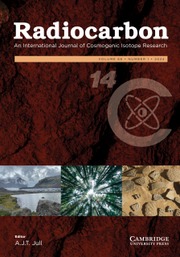Article contents
Buried Ancient Forest and Implications for Paleoclimate Since the Mid-Holocene in South China
Published online by Cambridge University Press: 18 July 2016
Abstract
The historical evolution of an ancient forest that developed at Gaoyao, south China, can be divided into 4 stages of radiocarbon intervals (1.1–1.5, 2.0–3.5, 3.6–4.0, and 4.3–4.9 ka) in which the last 3 stages all developed in a wetland and formed humic layers of 2.0, 0.5, and 0.7 m depth, respectively. The humic layers were interrupted by 2 white-gray silty clay layers that most likely formed during climate fluctuations. Four drought events were identified during the evolution of the ancient forest, occurring around 4.3, 3.6, 2.0, and 1.1 ka, respectively, with durations of ∼1000 14C yr. These events are consistent with other records both in low- and high-latitude areas, in particular with the little ice ages occurring since the mid-Holocene. Precipitation likely increased from 5.0 to 3.6 ka in south China, then decreased, which is probably the main cause for the development as well as the demise of the ancient forest.
- Type
- Soils and Sediments
- Information
- Radiocarbon , Volume 52 , Issue 3: 20th Int. Radiocarbon Conference Proceedings , 2010 , pp. 1411 - 1421
- Copyright
- Copyright © 2010 by the Arizona Board of Regents on behalf of the University of Arizona
References
- 7
- Cited by




